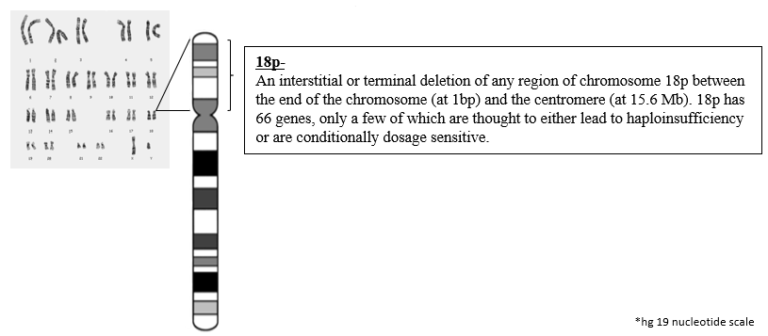What is 18p: A Sixty-Second Summary

(Aliases: 18p deletion, 18p- syndrome, partial monosomy 18p, de Grouchy Syndrome type 1)
ICD-10 = Q99.9 or Q93.89
Key points on genotype
- People with 18p deletions have some degree of genetic homogeneity. About half of the people have breakpoints in the centromere region and are missing all the genes on 18p. The remainder of the people have breakpoints scattered along the entirety of the short arm and therefore each have a different set of genes deleted.
- 89% are de novo events as opposed to inherited from a parent with a translocation.
- All parents should be genotyped for balanced rearrangements.
Key Points on phenotype
- Developmental delay is very common and is often the reason for initial detection.
- The average full scale IQ score is 69 with a range from 51 to 99.
- Life expectancy is believed to be near normal .
- Multiple congenital anomalies are possible. Specific phenotypes are determined by the specific genes deleted – see the section of this report on molecular implications.
Follow-up
- Affected individuals do not appear to be at increased risk for adverse reactions to drugs or standard medical treatments
- Recommendations for specific evaluations and treatments are on the following pages
Enrollment
- The Chromosome 18 Clinical Research Center is enrolling everyone with a chromosome 18 abnormality in our longitudinal study of all aspects of the conditions.
- To enroll, parents need to contact Annice Hill at hilla3@uthscsa.edu or call (210) 567-5321
- We need the diagnostic genetics report and any other informative medical records
- Once received we will send a kit for the blood sample.
Consultation
- Daniel Hale, MD, Medical Director of the Chromosome 18 Clinical Research Center can be reached through Annice Hill at hilla3@uthscsa.edu or call (210) 567-5321.
Updated 2020

